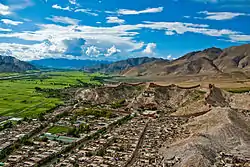Bakhtiyar Khalji's Tibet campaign
Bakhtiyar Khalji, the Muslim conqueror of Bengal under the Delhi Sultanate, launched a campaign to invade Tibet in the 13th century.[2]
| Bakhtiyar Khalji's Tibet campaign | |||||||
|---|---|---|---|---|---|---|---|
 Bakhtiyar Khalji led his army through harsh terrain into the cultivated valley of mainland Kamarupa and Tibet, where he met fierce resistance and a guerrilla uprising | |||||||
| |||||||
| Belligerents | |||||||
|
Mech tribe | Tibetan tribes | ||||||
| Commanders and leaders | |||||||
|
Ali Mech | Tibetan tribal leaders | ||||||
| Strength | |||||||
| 10,000 (approx.)[1] | Unknown | ||||||
| Casualties and losses | |||||||
| Several thousand; cavalry reduced to a few hundred | Unknown | ||||||
He was motivated by a desire to control the lucrative trade between Tibet and India. Tibet was a source of the most prized possession of any army horses and Khalji was keen to secure this route and control the trade by conquering Tibet. Also, controlling Tibet would mean he would control a part of the Silk Route, from China to Central Asia.
Background
The Muslims conquered Bengal after overthrowing the Sena dynasty in Gaur between 1198 and 1202. Bakhtiyar Khalji, the Governor of Bengal, subsequently became obsessed with ambitions of conquering Tibet. Historically, Bengal had trade relations with Tibet along the ‘Tea-Horse Route’, through Assam, Sikkim and Bhutan, to parts of China and Southeast Asia, which were home to gold and silver mines.[3] Tibet was also a source of horses.[4] Capturing Tibet would have allowed the Delhi Sultanate to control the northern Silk Road between China and Europe. The planned invasion also coincided with the Era of Fragmentation and the collapse of the Tibetan Empire.
The expedition was aided by Ali Mech, a tribal chief, in the foothills of Kamarupa. He was a recent convert to Islam, and he helped the expedition by acting as a guide for them.[5][6]
Campaign
On his way north, he invited the King of Kamarupa (Assam) to join him but the latter refused. After marching for 15 days through North Bengal and Sikkim, Khalji's army reached the Chumbi valley in Tibet. Surprisingly, they had faced little resistance but it soon became obvious why. The Tibetans had lured Khalji and his army into a trap. The rugged Himalayan mountain passes were an unfamiliar terrain to the invading army, who were more used to the sultry and humid plains of Bengal. The Tibetans inflicted heavy casualties on the invaders and Khalji decided to retreat. But, all along the escape route, the Tibetans continued to carry out relentless guerrilla-style attacks on the retreating army. Khalji's men were so badly defeated that the starving soldiers were forced to eat their own horses to stay alive.
On their way back to Bengal, the Army passed through the plains of Kamarupa (now North Bengal), while going through the territory of Kamarupa in the sub-alpine Himalayan hills, where his army crossed an ancient stone bridge on the river. The forces found the arches in the bridge to be destroyed by the Assamese which made it difficult to cross the deep river. In a desperate attempt to reach the other side of the river at Devkot, Khalji's forces lost a number of men and horses. It is said that of the 10,000-strong army that had marched into Tibet, only around 100 men returned.[7][8]
Aftermath
There are two accounts of what happened to Bakhtiyar Khalji following the Tibet and Kamarupa debacle. One account speaks of him dying from ill health and injury during this retreat to Bengal.[9][6] Another account notes that he was assassinated by Ali Mardan Khalji after returning to Devkot in Bengal.[7]
See also
References
- Debajyoti Burman (1947). Indo-Muslim Relations: A Study in Historical Background. Jugabani Sahitya Chakra. p. 67.
- Khan, Muhammad Mojlum (21 October 2013). The Muslim Heritage of Bengal: The Lives, Thoughts and Achievements of Great Muslim Scholars, Writers and Reformers of Bangladesh and West Bengal. Kube Publishing Ltd. p. 19. ISBN 9781847740625.
- Farooqui Salma Ahmed (2011). A Comprehensive History of Medieval India: Twelfth to the Mid-Eighteenth Century. Pearson Education India. p. 53. ISBN 978-81-317-3202-1.
- P. K. Mishra (1999). Studies in Hindu and Buddhist Art. Abhinav Publications. p. 101. ISBN 978-81-7017-368-7.
- Siddiq, Mohammad Yusuf (2015). Epigraphy and Islamic Culture: Inscriptions of the Early Muslim Rulers of Bengal (1205–1494). Routledge. p. 36. ISBN 9781317587460.
- Nadwi, Abu Bakr Amir-uddin (2004). Tibet and Tibetan Muslims. Translated by Sharma, Parmananda. Dharamsala: Library of Tibetan Works and Archives. pp. 43–44. ISBN 9788186470350.
- Nitish K. Sengupta (1 January 2011). Land of Two Rivers: A History of Bengal from the Mahabharata to Mujib. Penguin Books India. pp. 63–64. ISBN 978-0-14-341678-4.
- William John Gill; Henry Yule (9 September 2010). The River of Golden Sand: The Narrative of a Journey Through China and Eastern Tibet to Burmah. Cambridge University Press. p. 43. ISBN 978-1-108-01953-8.
- Ahmed, ABM Shamsuddin (2012). "Bakhtiyar Khalji". In Islam, Sirajul; Miah, Sajahan; Khanam, Mahfuza; Ahmed, Sabbir (eds.). Banglapedia: the National Encyclopedia of Bangladesh (Online ed.). Dhaka, Bangladesh: Banglapedia Trust, Asiatic Society of Bangladesh. ISBN 984-32-0576-6. OCLC 52727562. Retrieved 7 February 2021.